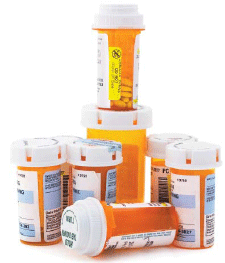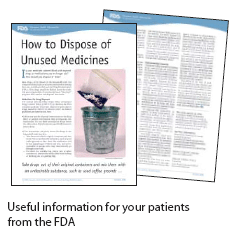What advice should I give patients and family members regarding disposal of old medications?
Flushing old medications down the toilet is not routinely recommended because they can contaminate the ground water. The best method of drug disposal is through a take-back program. Some cities hold prescription drug take-back events, where a law enforcement officer is present to supervise the collection of both controlled and noncontrolled substances. Patients and families can find out about these events by contacting their local government’s household trash and recycling service. Some pharmacies have secure drop boxes where patients can deposit their old medications. Patients and families should ask their pharmacist if these are available.
If there are no take-back programs in the patient’s community, advise patients to dispose of old or unused medicines in the following manner:
 • Remove or black out all identifying personal information from containers before disposal.
• Remove or black out all identifying personal information from containers before disposal.
• Pour the medication into a sealable plastic bag or other watertight container. Crush the medicine or add water to dissolve it, and then mix in a material such as kitty litter or coffee grounds (to make it less appealing for pets or children to eat).
• Seal the plastic bag and put in the trash for disposal.
Make sure patients understand that chemotherapy drugs, even those for oral administration, should never be flushed or thrown away. Patients should return these medications to their oncologist or to the pharmacy that dispensed them.
For more information on safe disposal of medications and for printer-friendly education materials to hand out to patients, go to www.fda.gov/ForConsumers/ConsumerUpdates/ucm101653.htm or www.smarxtdisposal.net/index.html.
How should patients dispose of narcotic pain medications?
Because of federal regulations, controlled substances cannot be returned to pharmacies. If there are no take-back events in the patient’s community that accept controlled substances, the FDA recommends flushing these medications or pouring them down the drain in order to prevent accidental ingestion.
 A current list of flushable medications, including multiple narcotics, can be found at www.fda.gov/Drugs/ResourcesForYou/Consumers/BuyingUsingMedicineSafely/EnsuringSafeUseofMedicine/SafeDisposalofMedicines/ucm186187.htm#MEDICINES. The Drug Enforcement Agency is working to update the standards for disposal of narcotic medications, so be sure to check the agency’s Web site for future updates.
A current list of flushable medications, including multiple narcotics, can be found at www.fda.gov/Drugs/ResourcesForYou/Consumers/BuyingUsingMedicineSafely/EnsuringSafeUseofMedicine/SafeDisposalofMedicines/ucm186187.htm#MEDICINES. The Drug Enforcement Agency is working to update the standards for disposal of narcotic medications, so be sure to check the agency’s Web site for future updates.
Here again, remind patients to remove or black out ALL identifying personal information from the container before disposing of this in the trash. Other suggestions include placing these containers within a larger item in their trash or blacking out the name of the drug. ONA
Lisa A. Thompson, PharmD, Assistant Professor, Department of Clinical Pharmacy, University of Colorado Denver School of Pharmacy, Aurora, Colorado.
